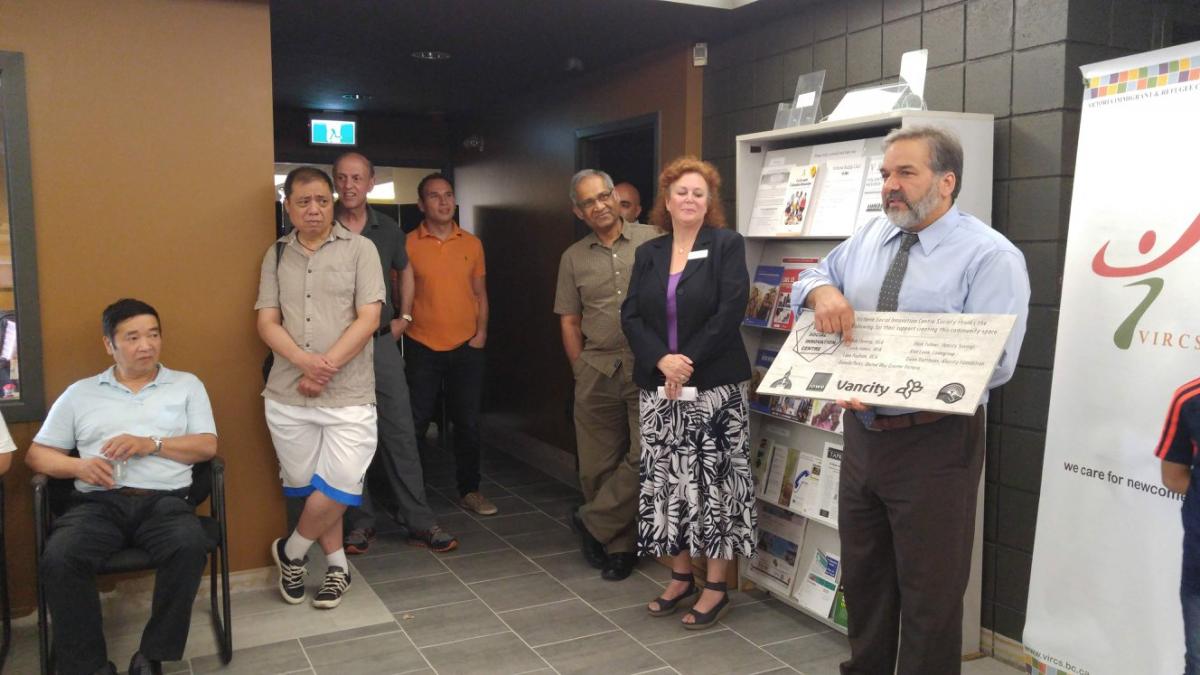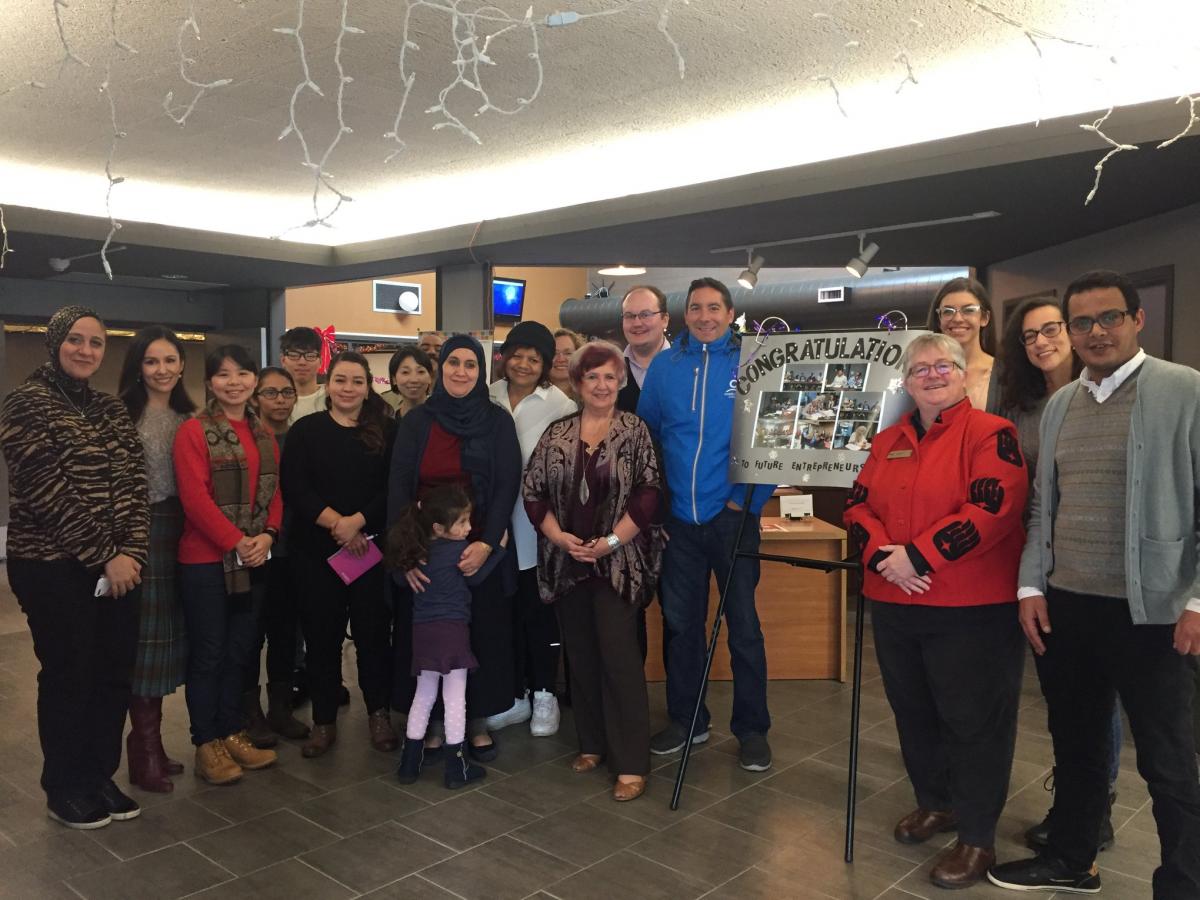Victoria Social Innovation Centre
Case Studies / Space profiles

Victoria Social Innovation Centre
Space Profile
- Name of Space: Victoria Social Innovation Centre (VSIC)
- Name of Occupants: Family Services of Greater Victoria (Family Services), Victoria Immigrant and Refugee Centre Society (VIRCS), Oasis Society for Spiritual Health, Programme d’immigration francophone de la Colombie-Britannique, Mosqoy
- Organization Type: Registered Non-Profit
- Society Mission:
- Family Services: Family Services of Greater Victoria helps children, youth, and adults manage the challenges of separation, divorce, or transition to a new family structure. Our highly qualified staff, working with other community agencies, provide information and practical or emotional support so people facing these challenges can make the decisions that are best for everyone. FSGV believes all individuals can find ways to move forward in their lives when family relationships have changed or are changing.[1]
- Victoria Immigrant and Refugee Centre Society: To assist in the settlement and adjustment of immigrants and refugees in Canada, and to provide services designed to increase the newcomer's participation in Canadian society, by assisting the newcomer to overcome barriers.
- Owner – Land: Victoria Social Innovation Centre Society
- Owner- Building/Improvements: Victoria Social Innovation Centre Society
- Rent/Lease/Own: Own and Lease
- Address: 1004 North Park Street, Victoria, BC V8T 1C6
- Square Footage: Approximately 17,000 sf
- Year Opened: 2017/2018
- Space/Facility Type: multi-purpose, office, community facility
- Services/Programs:
- VIRCS- federal settlement program, provincial settlement program, child and youth programs, community garden project, youth newcomer employment program, language learning and testing programs, newcomer volunteer coordination with other organizations, women’s development project, provincial anti-racism program
- Family Services- Separation resource services; parenting after separation and decision making skills classes; meditation for couples; counselling for youth, adults and couples; support for grandparents; group support programs; and facilitated parent-child connections
- Oasis- Integrated Recovery and Holistic Wellness, weekly community meals, nature retreats, and family connections for people experiencing homelessness
- Mosqoy- office space for their fair-trade textiles, travel and education programs in Peru
- Programme d’immigration francophone de la Colombie-Britannique provides employment services for for francophone newcomers to British Columbia
cASE sTUDY
Synopsis
Concept & Need
Partnerships & People
Planning, Feasibility, Acquisition & (Re)Development
Business Models & Operations
Funding & Financing
Impact & Lessons Learned
Synopsis
The Victoria Social Innovation Centre (VSIC) opened in the North Park neighbourhood of Victoria, BC in 2017. It is a non-profit owned and occupied community services hub, currently home to five non-profits delivering a range of services to individuals and families. VSIC’s creation is due in large part to an exceptional partnership between Family Services of Greater Victoria and Victoria Immigrant and Refugee Centre Society, whose Executive Directors envisioned a co-location /shared space beginning in 2015. Working with partners like Vancity Credit Union and the other non-profits that have come to fill the space, brought it to reality. The VSIC project was built around rigorous financial planning and leveraging existing operating budgets and facilities expenses into an innovative, sustainable ownership model. This has resulted in a long-term, secure space that is an asset to the community. The impacts on both of the lead organizations and the tenants who share the space with them has delivered value for the organizations and their clients.
Concept & Need
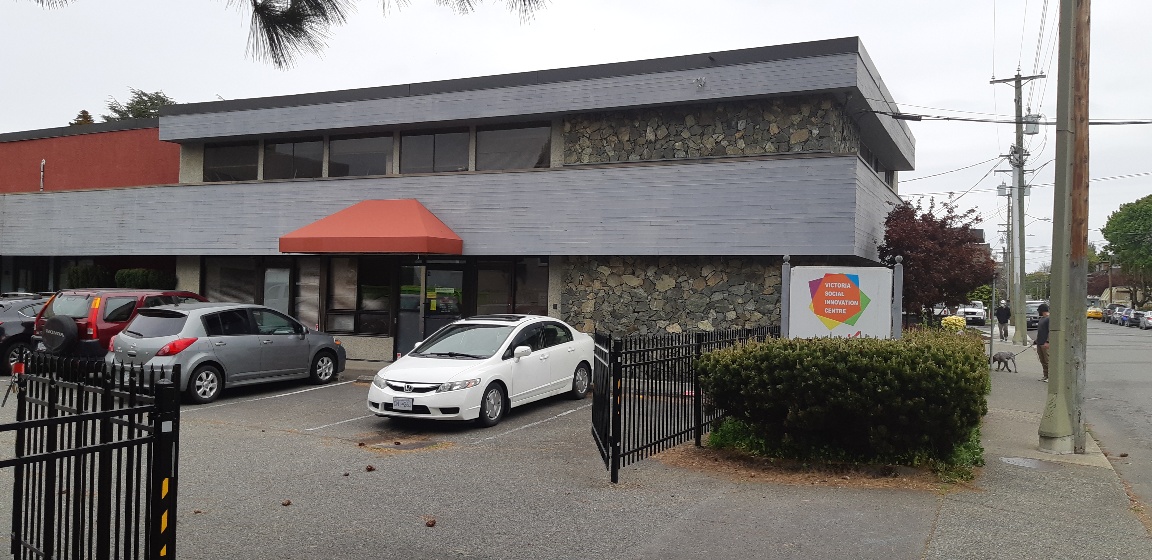 The Victoria Social Innovation Centre exterior. Photo Credit: Jane Taylor Lee
The Victoria Social Innovation Centre exterior. Photo Credit: Jane Taylor Lee
The sequence of events that led to the creation of the Victoria Social Innovation Centre (VSIC) was set in motion in 2015, when the Victoria Immigrant and Refugee Centre Society’s (VIRCS) Board of Directors asked David Lau, the Executive Director, to find a long term solution to the real estate challenges the organization had been facing. Over the last several years, VIRCS had been struggling to pay rent for a space that was not ideally suited to their needs. In the short term, their landlord had halved their rent to allow them to remain in the space, but this was not a sustainable solution.
David started considering VIRCS’s strengths in order to determine a direction, and he landed on one in particular: collaboration. At that point, VIRCS had a 25-year history of working closely with other organizations to connect newcomers to the programs and services they needed. This established model of partnerships and collaboration led David to think about co-location as a potential solution to VIRCS’s space needs. He reached out to all of the organizations they worked closely with, and a few others, to see who would be interested in co-locating with the Immigrant and Refugee Centre. During this time, he also reached out to Vancity Credit Union to learn about possible financing options for such a project. Mark Fulmer from Vancity alerted David to the fact that Big Brothers Big Sisters Victoria was leaving the fifty-year lease they had held with the City of Victoria on an old firehall they had converted into a social purpose space, and the City was accepting proposals for new tenants. By this time, David had assembled a group of four organizations interested in co-locating, including Family Services of Greater Victoria (Family Services). At first the City was encouraging of the proposal, but eventually went in another direction. When this opportunity fell through, two of the potential partners backed away, leaving VIRCS and Family Services to forge ahead.
By this time, Bruce McGuigan, the ED of Family Services, had become passionate about the co-location/shared space concept that ultimately led to the Victoria Social Innovation Centre. Family Services had also faced a variety of space-related challenges in past years, and, like VIRCS, their survival as an organization was on the line. Both organizations were well established, VIRCS was established in 1989 and Family Services in 1978, and even despite their proven longevity, both organizations struggled from year to year, largely due to the high cost of rent--Family Services was paying more than their annual budget could sustain, and only using a very small percentage of the space on a regular basis. VIRCS was in a similar place with rental costs eating up too much of their annual operating budget. Both organizations had identified co-location as a way to share less-frequently used spaces like board rooms, and to maximize use of spaces like kitchens and washroom. In addition, both organizations stood to benefit from client referrals between their organizations, facilitated by their locational proximity. They also saw a need for secure space—space that wasn’t subject to changes in the real estate market—for the broader social purpose sector in Victoria. Creating space that would benefit more than just their organizations was key to the VSIC concept.
“We were renovicted from our previous space, rents were going up across the area… we had already as an organization faced one move as a consequence of this and now we were facing another, so we were looking for alternatives to have a permanent home.” – Bruce McGuigan, former ED, Family Services; Professor of sociology, Vancouver Island University
Given their past experiences of the challenges and uncertainty of leasing space, Bruce and David decided their way forward would be ownership. They came up with an organizational structure that would allow VIRCS and Family Services to jointly own the building, while ensuring it would remain a social purpose space in the community in perpetuity. To do this, they created the Victoria Social Innovation Centre Society, a legal entity whose board is made up of the Board presidents and EDs of VIRCS and Family Services. This innovative structure allows VIRCS and Family Services to partner in the organization that owns VSIC, while simultaneously protecting it and their organizations from the ups and downs of the real estate market and non-profit funding cycles (as explained in more detail in the “Business Models & Operations” section below).
“Our intention [was] to create a space of collaboration where economic necessity is not our only interest but, mutual intents and collaborative benefits are shared by all participating organizations. Now that we are all together, we are starting to look at how we can solve problems mutually. We have turned the corner and are utilizing each organization’s strengths when we find solutions and new programming outcomes. Our boards, executives and operational staff are starting to strategize with each other, and we are truly finding new ways of supporting one another as we serve our mandates. It’s a very useful thing.”- David Lau, ED, VIRCS
VIRCS and Family Services spent some time looking at spaces available on the commercial real estate market to house the VSIC, but couldn’t find the right fit. Eventually, Mark Fulmer heard about 1004 North Park Street, which was being sold by the Multiple Sclerosis Society of Canada and told David and Bruce about it. The building needed some renovations, but since it was already set up for a social purpose organization, the zoning was right and it was a better fit than many others.
David and Bruce had run the numbers to know that they could purchase and renovate the building. Additional help came in the form of Owen Matthews, Chairman of the Alacrity Foundation. Matthews is an experienced investor in tech real estate in Victoria, and used his negotiation skills, pro bono, to get a good price on the site. He purchased the building and signed it over to the Victoria Social Innovation Centre Society, and VIRCS and Family Services paid back this cost. Family Services moved into their portion of the space in the summer of 2017, and after the necessary renovations were complete, VIRCS moved in in January 2018.
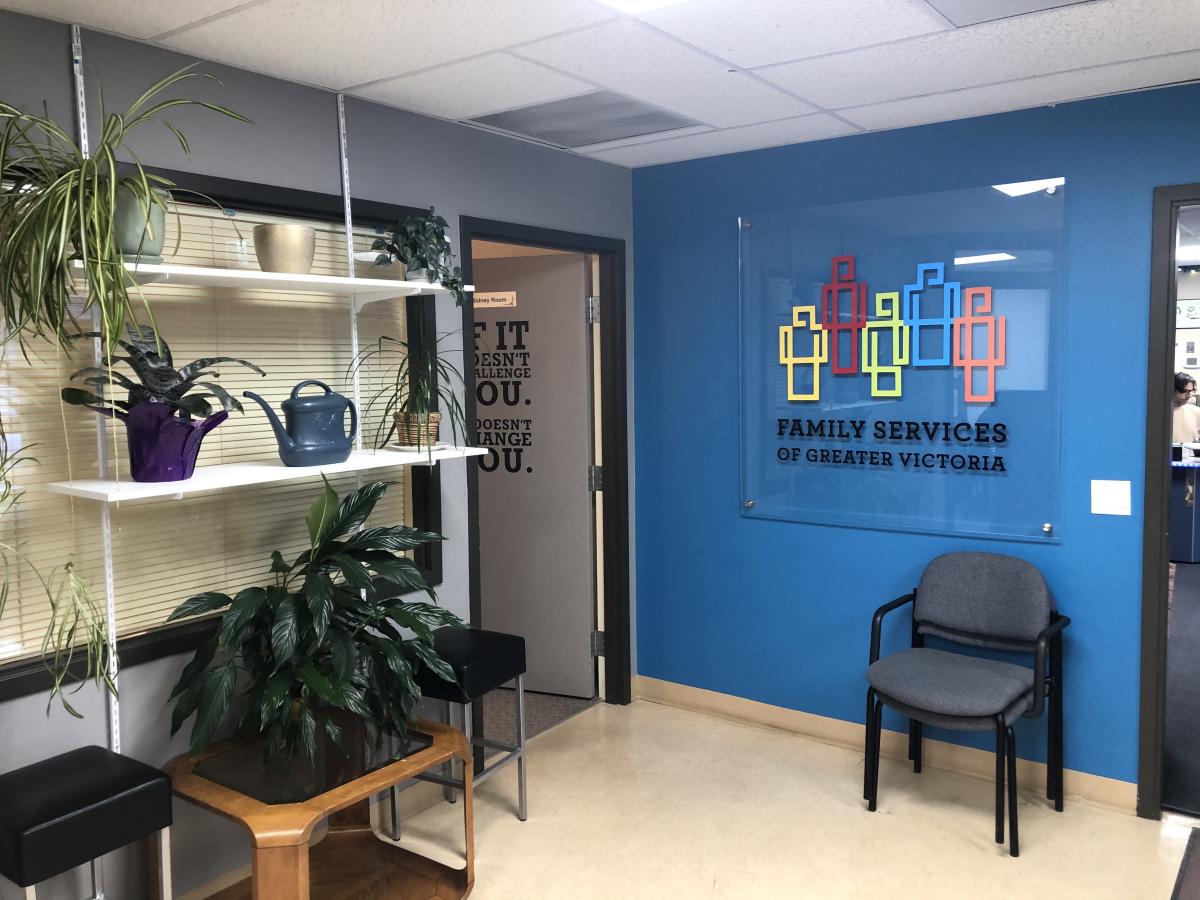 Family Services Reception. Photo Credit: Liana Glass
Family Services Reception. Photo Credit: Liana Glass
“When you think about it, it’s so progressive, and yet it’s a fairly simple concept, if you’re prepared to collaborate… really be invested in the community, not just in terms of your own agency but the overall benefit of the community… and just really be ready to roll up your sleeves and say, what can we do to help?... The concept is brilliant, and I really hope that as a result of what we’re able to do here, and what people see that we’re doing and learn about what we’re doing… that it simply becomes how non-profits operate.” – Jane Taylor Lee, ED, Family Services
Since it opened, VIRCS and Family Services have been joined in the Innovation Centre by three tenants: Mosqoy, Oasis, and Programme d’immigration francophone de la Colombie-Britannique. Over 8,000 remaining square feet of space is being renovated to create additional suitable space for social purpose organizational tenants. Half of that remaining space will become the first trauma-informed childcare centre in North America, built by the Victoria Social Innovation Centre. The childcare centre will provide designated spots for children who have experienced trauma, and its programming will incorporate trauma counselling. It will be an independent, revenue-generating social enterprise: a project of VSIC Society and an important part of the VSIC vision.
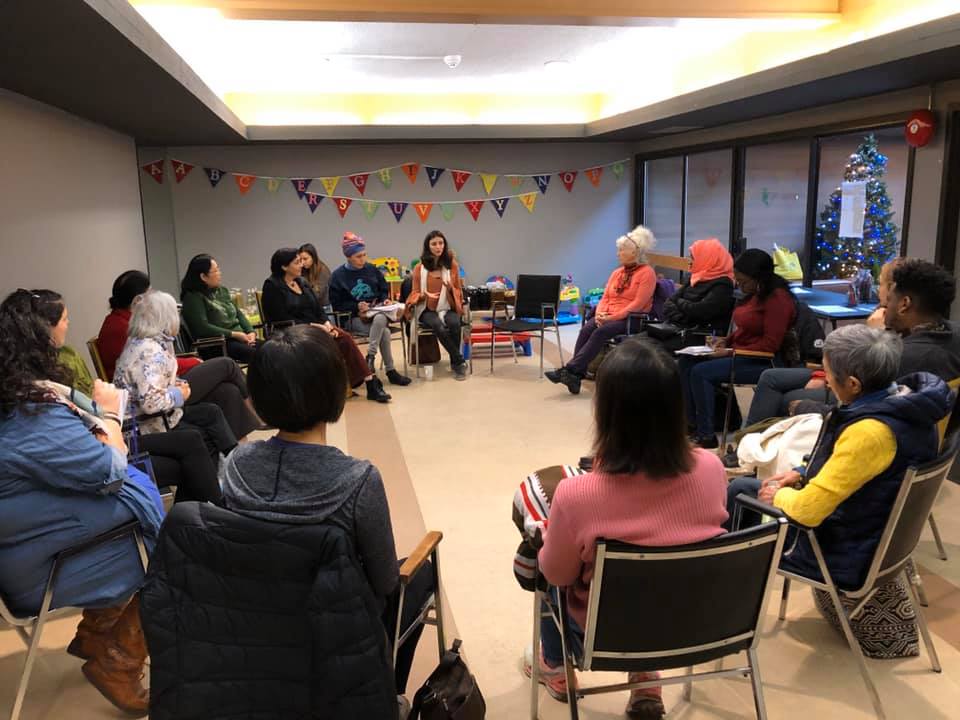 VIRCS programming taking place in the VSIC multipurpose room. Photo Credit: VIRCS
VIRCS programming taking place in the VSIC multipurpose room. Photo Credit: VIRCS
Partnerships & People
David Lau and Bruce McGuigan, the EDs of VIRCS and Family Services at the time, were clearly the champions of and driving force behind creating the VSIC. Both were determined, optimistic and creative, and they worked well together and trusted each other throughout the project. They also brought a financial rigor and acumen to the project that enabled their Boards to move forward with the co-location/shared space and creation of VSIC. Their financial analysis proved the organizations would benefit and the move from renting to owning would work. They both also put an enormous amount of time and energy into the project—by all accounts, VSIC would not have happened without them.
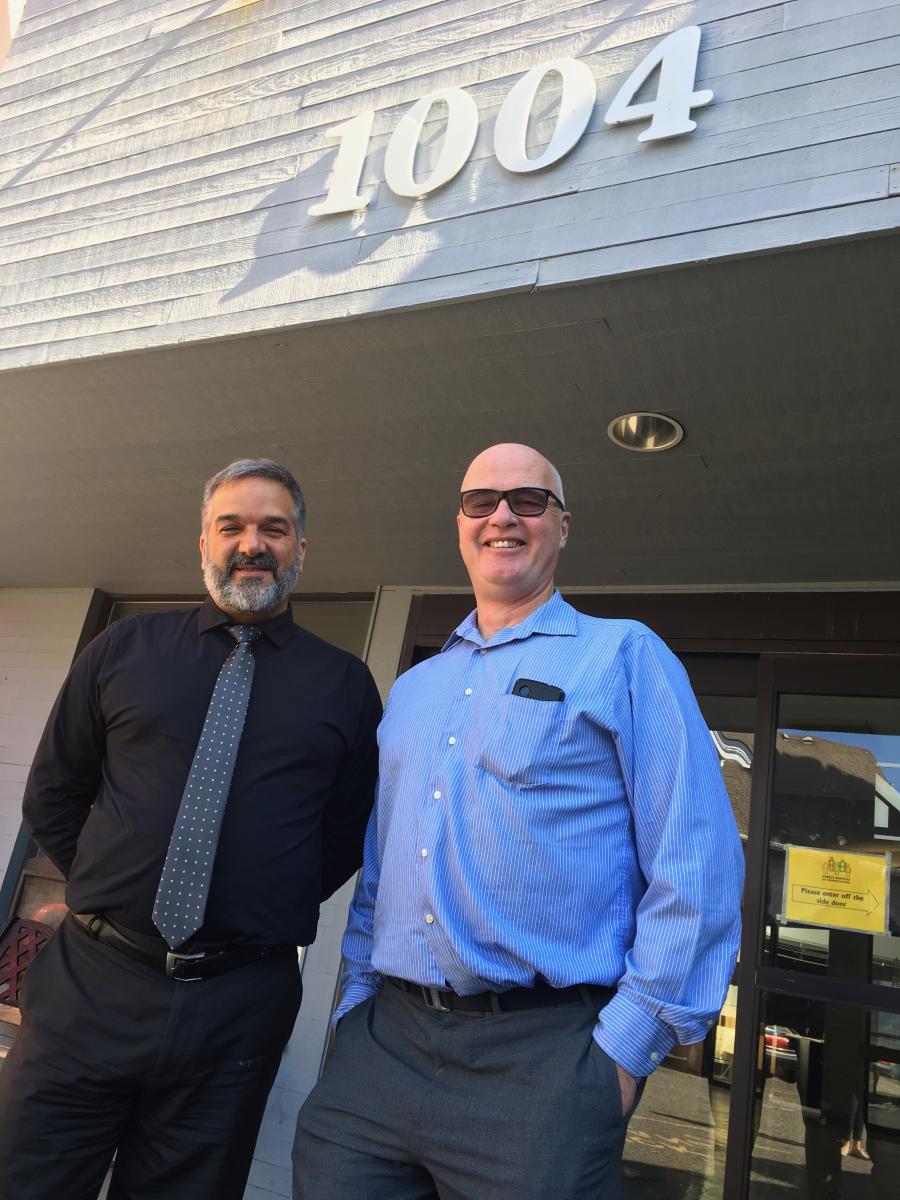 David Lau and Bruce McGuigan. Photo Credit: Jacqueline Gijssen
David Lau and Bruce McGuigan. Photo Credit: Jacqueline Gijssen
The Boards of both organizations also played a large role, in fact Bruce describes them as “heroes.” Both organizational Boards, and then ultimately the VSIC Board, had to get behind the vision, and reach consensus on the steps along the way. A Memorandum of Understanding was drafted and signed between the boards to give David and Bruce the green light to look for space together, and the boards have continued to work collaboratively ever since. Now that VSIC is in operation, the boards have shared bylaws for how the space will operate, and board members can be traded between the two partner organizations to increase collaboration and transparency.
“The idea of taking a bold risk, especially for the board of Family Services, was … bold but it was also a mature recognition of the circumstances under which we survived: … yeah it might kill us, but every year might kill us. As long as we’ve done the numbers, done the work, and it looks okay, let’s just do it.” – Bruce McGuigan, former ED, Family Services; Professor of sociology, Vancouver Island University
Mark Fulmer from Vancity was also a “core believer,” as David puts it, in the concept from the beginning. He provided help both looking for real estate and securing the necessary financing. Financially, Vancity was an invaluable institutional partner. The United Way, who provided some pre-development funding, and Owen Matthews from Alacrity Foundation, who negotiated the price of and purchased/held the site for VSIC, were also essential partners.
Rupert Downing, who was the ED of the Community Social Planning Council, one of the four organizations that were part of the original firehall proposal, also played an important role. While his organization did not ultimately end up partnering in the VSIC, Rupert contributed to developing and refining the concept of what such a shared space would look like.
When Bruce left Family Services and was replaced as ED by Jane Taylor Lee, she took up responsibility of navigating operations within this new VSIC structure, and considering ways to improve it moving forward. Jane is a firm believer in the model and sees it as crucial to Family Services’ survival.
“Clearly VIRCS and Family Services are [a] pretty terrific partnership, and most of that is the result of David and Bruce connecting and talking about their respective agencies and the challenges those agencies faced and then saying, you know, there’s got to be something to this.” – Jane Taylor Lee, ED, Family Services
In hindsight, there were some partnerships that did not work out, but did help VSIC take its current form, so are worth noting. The City of Victoria did not end up being able to provide the firehall space, but City Council ultimately voted unanimously to ease land tax obligations as long as all VSIC operations are non-profit. David and Bruce could not find other suitable partners to commit to the VSIC vision as equity partners. While many other organizations found it interesting, when it came time to join, the leadership teams or Boards were not able to make the move. In order to embark on a co-location/shared space project like this, an organization needs to be very well managed, both financially and operationally, and be confident in collaborating with other, possibly very different, organizations. A shared set of values and operating principles are essential.
Planning, Feasibility, Acquisition & (Re)Development
David Lau holds a tile recognizing the partners invovled in the creation of the VSIC at an open house in 2018. Jane Taylor Lee is to his right. Photo Credit: VIRCS
Timeline
- Concept/Idea: 2015
- Business Plan: 2017
- Building Purchased: 2017
- Initial Renovation: 2017
- Move-In: Summer 2017 for Family Services, January 2018 for VIRCS
- Childcare and additional tenant space renovation: 2019/2020
Planning for the VSIC began when David knocked on Bruce’s door in the summer of 2015. Together they began building increasingly detailed plans, from what co-location could look like to assessing the financial feasibility of buying the site at 1004 North Park Street. This step also included a business plan, used to secure funding from Vancity, explaining how every square foot of the building would be monetized, and what operating and other capital the two organizations would bring to the project. Since this project involved renovating an existing building that had been in use for similar community social services, zoning and code issues were minimal and there was no requirement for community engagement on the renovation project.
Once purchased, VIRCS and Family Services set out on the necessary renovations to improve the space. One wing of the building was set up for Family Services’ needs, with a private entrance, which is essential given the nature of the services they provide. All they had to change was the placement of one wall, and to paint the space. The shared spaces and VIRCS’ spaces required further renovations, which accounts for their later move-in to the building. Those renovations included redesigning the lobby; creating a boardroom, storage spaces, sound-proof interview rooms, and a computer lab; finishing and painting; and installing ventilation. One challenge the project encountered in this process was the unavailability of contractors to do the finishing touches on the renovations because of the construction boom in Victoria at the time. David and Bruce spent the last three weeks of 2017 doing this work themselves-- tiling and painting to make the space ready for VIRCS to move in in early 2018.
Renovations to the 4,500 square foot childcare space on the second floor, and the 4,000 square feet below it, are ongoing, but are expected to be completed in 2020.
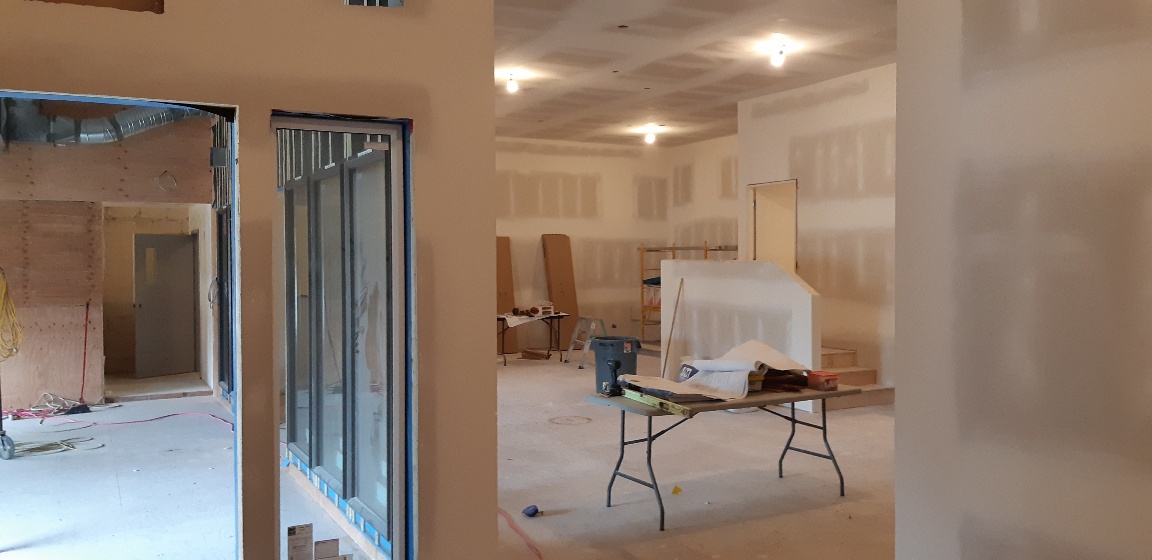 Ongoing renovations in the soon-to-be childcare space. Photo Credits: Jane Taylor Lee
Ongoing renovations in the soon-to-be childcare space. Photo Credits: Jane Taylor Lee
Business Models & Operations
“We incorporated a separate non-profit [VSIC Society] that owns the building so that the building, as a community resource, is protected from potential problems that may occur in any of the non-profits that are partners in the organization, so the building can’t be incumbered by the debt of any of the non-profits and nor do any of the non-profits get any money back if they leave.” - Bruce McGuigan, former ED, Family Services; Professor of sociology, Vancouver Island University
The unique and innovative ownership and operational model of the Victoria Social Innovation Centre is central to its exceptional nature. VIRCS and Family Services created the VSIC Society, the non-profit entity that owns the building, and each organization appoints members to the Board of VSIC. Originally, VIRCS and Family Services had hoped to find additional organizations to become equity partners in the Innovation Centre, however at this time it remains the two lead organizations. Although they invested significant equity to secure the space, VIRCS and Family Services are tenants in the building: they pay rent to the Innovation Centre Society. Because they also appoint members to the Board of the Innovation Centre, however, they cross over between the roles of “landlord” and “tenant.” Another tenant-organization could become this type of partner by contributing to paying back the equity VIRCS and Family Services invested in establishing VSIC.
A second occupancy model exists for not-for-profits who do not wish to be part of the equity partnership. These organizations, currently Mosqoy, Oasis, and Programme d’immigration francophone de la Colombie-Britannique (a program of la Fédération des francophones de la Colombie-Britannique), are tenants at VSIC and hold lease agreements with the Society.
Each partner/tenant has their own designated office and program spaces for services that require security and confidentiality of the clients. In addition, there are two types of shared spaces in the building: common space like the lobby/reception, atrium, hallways, bathrooms, kitchens, and stairwells; and bookable shared spaces including a multi-purpose room, board room, interview rooms, and the computer lab.
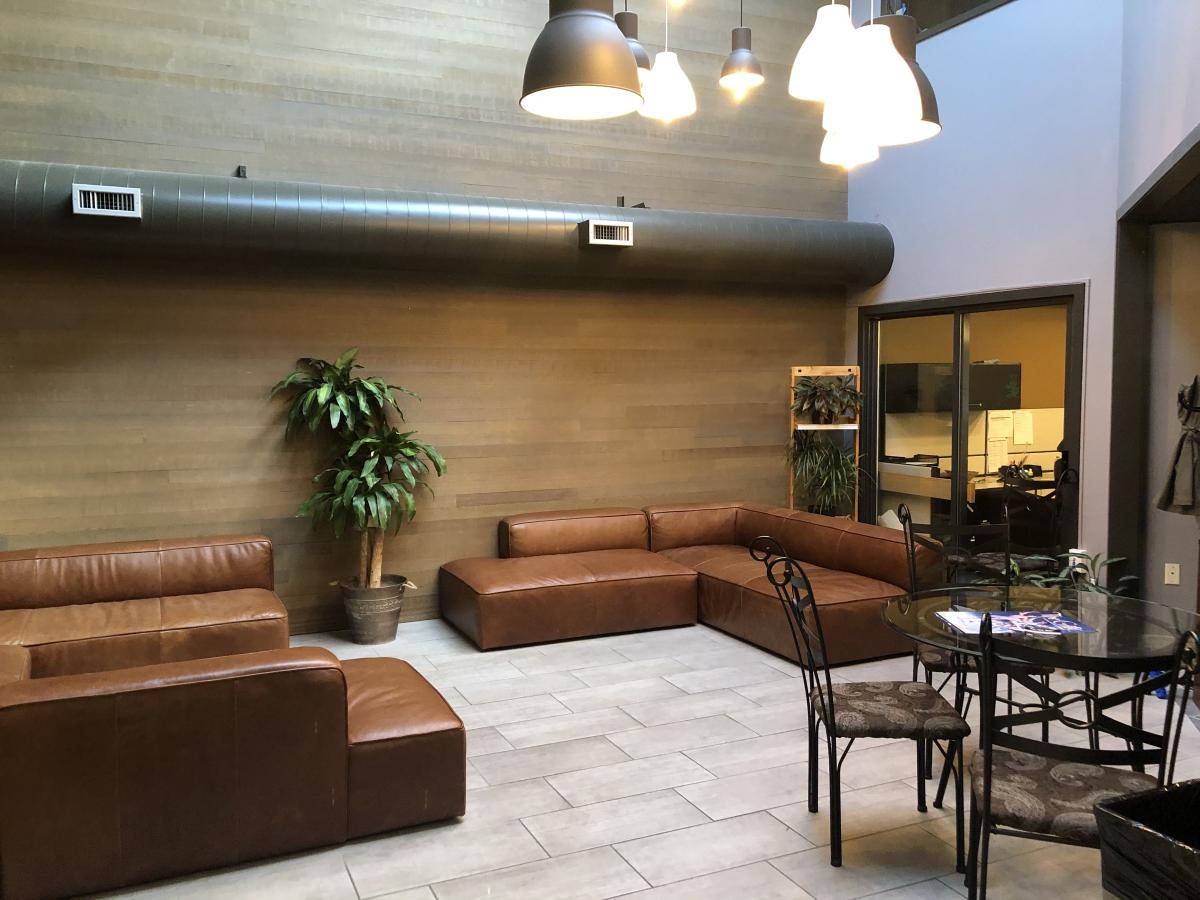 The ground floor atrium, one of VSIC’s common spaces. Photo Credit: Liana Glass
The ground floor atrium, one of VSIC’s common spaces. Photo Credit: Liana Glass
In terms of its financial operations, VSIC Society collects rent from all organizations. For the time being, these rents go toward paying VSIC’s mortgage. Once the mortgage is paid off, however, the surplus from the rents will be put toward VSIC programming or redistributed to the equity partners in the form of grants. Bruce estimates that when the VSIC is fully leased out, it will bring in between $300,000 and $350,000 a year in revenue from rents, while operating costs will add up to roughly $220,000. This means that as the mortgage payments decrease and then disappear over the next 20 years, that positive cashflow will pay for VSIC’s programs, with any surplus netted back into the partner organizations. The other tenants benefit financially from this structure as well: while they do not stand to get any surplus dollars back, they have long-term, secure space, and their rent is below market rates.
“This is a society owned by member societies, which can grow, and if a member society steps away, they don’t get any equity out… so it’s in their best interest to stay.” – Mark Fulmer, Vancity
VSIC became financially stable the moment VIRCS moved in, as even without the rest of the space being filled by other organizations, their monthly payments to pay off VSIC’s mortgage were already lower than what they had each been paying in rent in their previous spaces. In order for the space to be optimized, however, all remaining space is to be leased by additional organizations. The primary example of this is the 4,500 square feet for the childcare centre and the 4,000 square feet below it that are currently being renovated. Once these are running and occupied they will both bring in revenue, and no longer be costs borne by VIRCS and Family Services.
“What’s cool about the Social Innovation Centre, [is that] we are tenants here, and we’re building equity in the building, but if Family Services were to leave, we [wouldn’t] take a portion of [that equity], so any equity that’s been built up is there as a legacy… So, regardless of who comes into the building they will benefit from the fact that we set it up the way we did. We’re going to get everybody’s operating costs down, which means that the moneys that are freed up can then go back into programs and services.” – Jane Taylor Lee, ED, Family Services
Ideally, to optimize the model further, there would be more than just two partner organizations, and VIRCS and Family Services are hopeful to add a third partner when they find the right organization. One of the reasons this will be beneficial, and that David and Bruce worked so hard to try to find a third partner in the beginning, is that having three, or any un-even number, of partners, provides for a better governance system. Currently, because VIRCS is responsible for roughly 60% of the space, and Family Services for 40%, with Board members’ votes allocated proportionately to their share of the space, there is a slight imbalance of power that could skew decisions in tough situations.
Beyond the legal and financial operations of the space, however, the VSIC model also encourages and creates opportunities for collaboration between organizations. The services provided by the various organizations are in some cases very compatible, and they are able to refer clients between them with ease. The organizations can also support each other’s services. If Family Services needs a translator, for example, they can walk down the hall to VIRCS and ask if someone there speaks the language they need. In addition to these day to day supports, the organizations have also started to seek and apply for funding together.
“Being in this little building of community, we can easily ask each other, ‘hey, what do you feel about this? Or, do you want to collaborate on this?’… I think in each of our personal lives we have that sense of collaboration and family and building one another up, not silo-ing each other ... [Here] we’re going to uplift one another and see how we can help one another.” – Brianna Bear, ED, Oasis
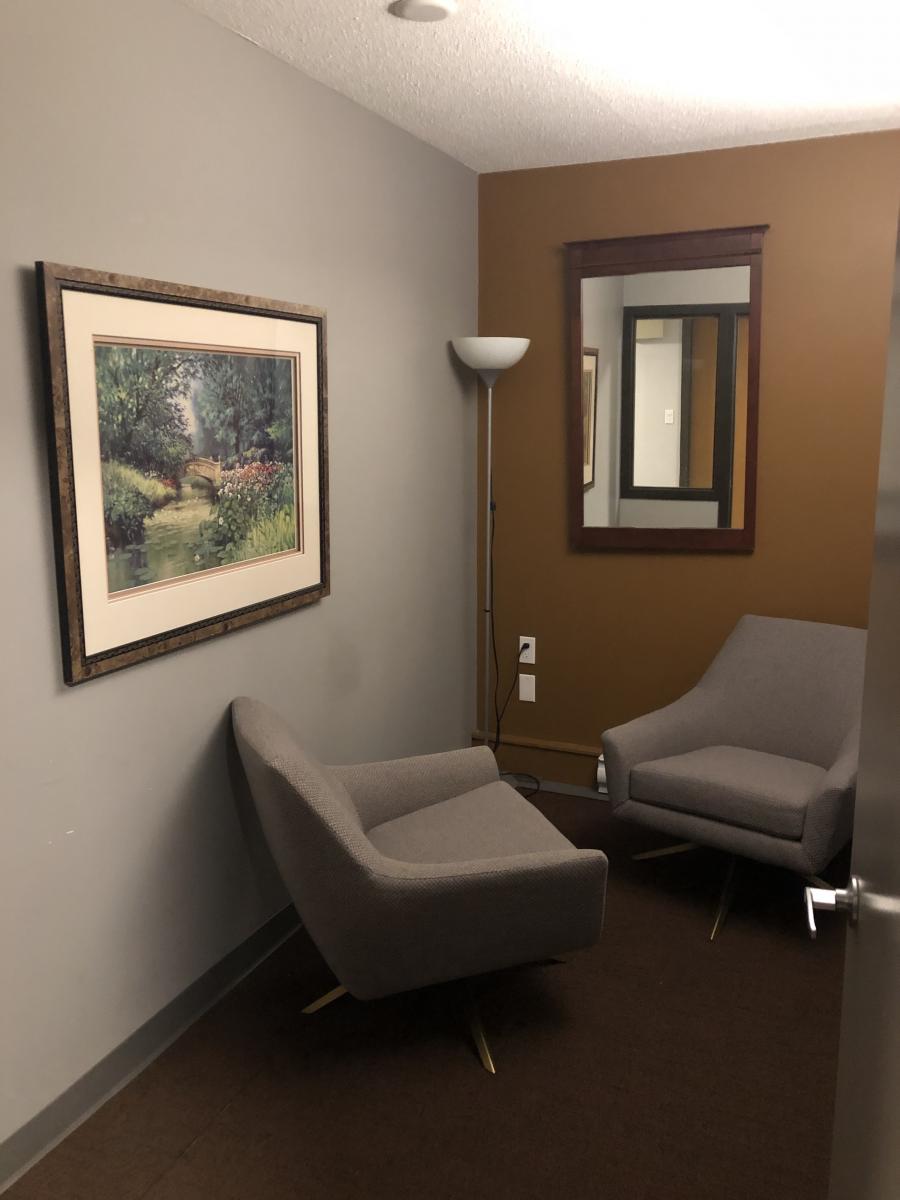 One of the interview rooms created during the initial renovations in 2017. Photo Credit: Liana Glass
One of the interview rooms created during the initial renovations in 2017. Photo Credit: Liana Glass
Funding & Financing
Key financial steps to realizing the project included securing financing from Vancity Credit Union, Owen Matthews’ help to negotiate the sale price and assist with sale completion and transference to VSIC, and the financial rigor with which VIRSC and Family Services approached the entire process. The financing from Vancity Credit Union was slightly more complicated than some social purpose real estate purchases because VIRCS and Family Services did not have 25% for a down payment. Normally, a financial institution will only finance a project like this up to 75%, but one of Vancity’s unique features is that they have loan pools that they can use to set aside additional funds to secure loans to not-for-profit organizations, as they did in this case. While it included more steps to secure the funding because of this, the project’s aims were well within Vancity’s Community Impact Investing goals, so it was more a matter of finding the exact dollars needed to fund the project, rather than of convincing anyone at Vancity of VSIC’s worth.
Internally at VIRCS and Family Services, while both organizations had had their financial struggles, they were well managed and able to do the necessary planning to figure out that creating VSIC and purchasing the space made sense for both of them. Between 2017 and 2020, VIRCS and Family Services put roughly $300,000 into the building in the form of the deposit, a portion of the renovation costs, and the transactional costs of purchasing the real estate. The one financial hiccup in the process was that the transactional costs of purchasing the building were higher than VIRCS and Family Services anticipated. However, because of their otherwise solid budgeting, they had the contingency funds necessary to cover the additional cost.
VIRCS paid many of the initial costs of the project (including the deposit and legal fees) up front because they had non-designated reserve funds that allowed them to do so. Family Services contributed what they could and then paid VIRCS back proportionately over the first six months of operations. VIRCS also paid rent for their space while it was being renovated before they could move in in order to make the VSIC feasible. This arrangement set the precedent for the flexible and collaborative approach that is expected of all organizations that join the Innovation Centre and that ultimately makes them and the facility stronger together.
Site purchase price: $2.6 million
Cost of initial renovation (2017): $250,000
Cost of childcare renovations (2019/2020): $750,000
In addition to VIRCS’ and Family Services’ cash and in-kind contributions, funding and financing for the project were provided by Vancity Credit Union, a pre-development grant from the United Way, and a Gaming renovation grant. The Innovation Centre site was appraised in March 2020 at $4.35 million, representing a significant return on investment for the VSIC. If the social and organizational benefits of colocation weren’t already enough to convince potential adopters of this model of its success, surely the numbers will prove convincing.
Impact & Lessons Learned
“I think everyone’s pretty happy. There was a real effort made to create welcoming spaces, and create sort of a relaxed, welcoming, easy space, where there’s adequate room for everyone.” – David Lau, ED, VIRCS
Overall, VSIC was an immediate success, and because it was set up to be a long-term community asset its impact should only continue to grow, especially as more organizations move in and the childcare centre is completed. For now, certainly, the space meets the needs of the organizations it houses by providing secure, welcoming and suitable spaces. An essential part of its success is that it is already meeting one of David and Bruce’s original goals: to provide secure space to smaller, more vulnerable non-profits, in addition to meeting their organizations’ needs. Beyond this, the organizations are able to support one another by making referrals and collaborating on applications and programming.
“Yes, [it has delivered on its promise] completely. We have a secure space that is immune to the real estate market. A forever home.” – Bruce McGuigan, former ED, Family Services; Professor of sociology, Vancouver Island University
As for the users of the space, they mostly seem appreciative of the services they receive at VSIC, rather than of the space itself. But, a large part of this is the warm reception people receive when entering the building: VIRCS’s reception desk is in the main lobby, and welcomes participants and clients from all the tenant-organizations, not just VIRCS. This shared service is one of the benefits of co-location, and creates a warm atmosphere for visitors. In the broader community, VSIC has a low profile, largely because North Park is a relatively quiet street. The Innovation Centre’s notoriety is expected to increase in the general community once the childcare centre opens and starts bringing new people to the space.
“So far we have family services, newcomer services, indigenous health and culture activities, francophone employment and international development in one location. Even at this early point, it is terribly exciting for me to walk down the hall and smell sweetgrass burning in a room where Syrian women are learning from Coast Salish artists how to make traditional drums in the context of an ESL class. This is Canada. This is how great things can be when you get really intentional about them; it is only going to get better when we add a specialized daycare and more exciting, curated partner organizations.” - David Lau, ED, VIRCS
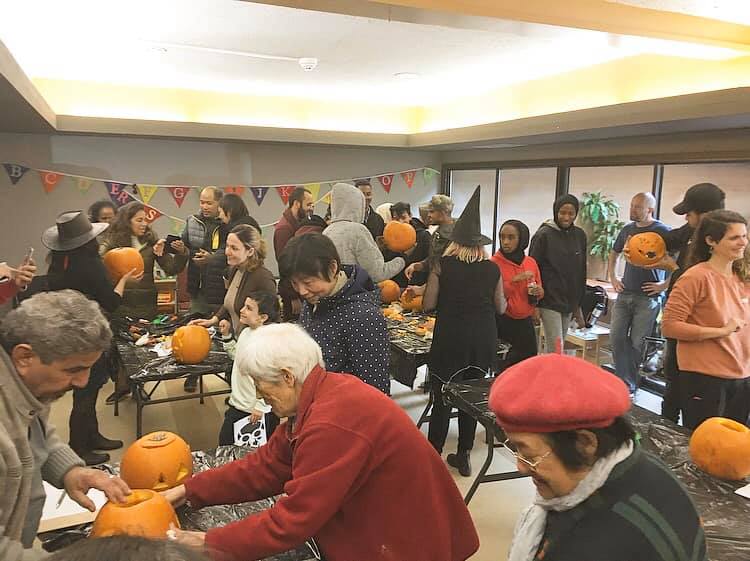 Halloween activities in the multipurpose room. Photo Credit: VIRCS
Halloween activities in the multipurpose room. Photo Credit: VIRCS
The security of tenure has had huge impacts on the organizations involved. The piece of mind that comes from not having to worry about where they will be a year from now, or even five, alleviates stress and creates opportunities to focus elsewhere. This is not to say there haven’t been challenges. In the early stages, overcoming the negativity and doubts of other organizations and possible partners took grit and determination from David and Bruce and their respective boards. Once the Innovation Centre was up and running, figuring out the day to day elements of managing the space, and the partnerships involved has been a steep and on-going learning curve. The long-term commitment as well, while providing security, maybe eventually come to be a limiting factor as the organizations look to expand their programming. Overall, though, everyone agrees the net benefits have been positive, and things are working very well.
“This idea of a hub and a place where non-profits can go and seek refuge in a way, is such a progressive, visionary, exciting prospect, I mean we’re really thrilled to be in it, we really are. And it really has ensured our survival.” – Jane Taylor Lee, ED, Family Services
Some of the positive impacts of the space on its tenant organizations have yet to be realized. As discussed in “Business Models & Operations,” the ownership structure of VSIC will eventually generate positive cash flow that will be put back toward programming in the space and net surplus back to the two lead organizations. What this means on an individual organizational level will vary from tenant to tenant. For Family Services, for example, once the space is fully occupied by tenant organizations, their portion of the rent will go down to approximately $32,000 a year. Compared to their rent in their previous space, which was $94,000 a year, that will leave them with an additional $60,000 dollars a year to address key needs. Once this comes to be, Family Services will be able to increase the wages they pay their staff, or make other internal improvements, as well as improvements in their programming.
“The reality is, we knew when we got in here that we were now finally in a position where we could ensure the sustainability of the organization… we know now that we’re here, we’re not going anywhere, there’s a sense that we can lay down roots.” – Jane Taylor Lee, ED, Family Services
Celebrating the completion of a VIRCS' entrepreneurship skills training program. Photo Credit: VIRCS
The innovative partnership and legal structure that made this space possible is a highlight and key takeaway from the project. It is essential to the existence and success of VSIC, and hopefully can act as a model for other organizations considering co-location. The security of tenure and potential for long term financial benefits are unique and exciting.
Another key takeaway from this project is the importance of finding compatible partners to share your vision and then to be willing to put in the work. David and Bruce worked very well together, as do VIRCS and Family Services and their Boards within the Innovation Centre Society governance and tenanting structures. Other organizations considering similar projects should very thoughtfully consider their potential partners, as well as their own strengths and weaknesses.
“[Focus] on what your strengths are. If your strengths are collaborating, well then this model might work for you. If your strengths are not collaborating, then this is not going to be the solution.” – David Lau, ED, VIRCS
Even for organizations looking to rent, rather than to create a whole new model of social purpose real estate, like the non-partner tenants of VSIC, for example, the importance of partnerships is paramount. It allows organizations to collaborate and opens doors to new opportunities, including helping find space and building long term relationships.
“Build connections. Collaborate with people, invite them for food. Food is how you get people to your table and to your door and people to get to know you.” – Brianna Bear, ED, Oasis
Bruce and David both also highlight the importance of organizations being well managed operationally and financially, warning that if this is not the case, a project like setting up VSIC could ruin them. A key part of this is to plan thoroughly for any social purpose real estate endeavour. Simply having the will to complete a project isn’t enough: non-profits need to ensure they have the capacity to complete such a project as well.
Another long-term benefit of the VSIC’s collaborative ownership structure is that when enough equity is established, it can be used to purchase buildings and set up new hubs in regions that are strategically important to the partner organzations. They will be able to expand their services in these areas, and perhaps new member organzations who want to stabilize and further develop their services will join them.
Next on the agenda for VSIC is to complete the renovation of the childcare space and the space below it. The childcare centre will be a social enterprise under the umbrella of VSIC Society, and will be the first trauma-informed childcare centre in North America. VSIC Society will run the childcare for the first ten years, at which point they, and the Provincial Government who are funding the project, will re-evaluate the management structure. The childcare centre will also offer operating hours that will make it accessible to single parents and parents who do shift work.
VSIC is set up on the idea that social purpose organizations should have access to, and be able to own and manage, spaces that create environments where they can thrive. Too often, social purpose organizations are forced to take the first opportunity that comes their way, but projects like VSIC show what happens when they make opportunities to create better environments for themselves.
Interviewees:
- Jane Taylor Lee: Executive and Clinical Director of Family Services of Greater Victoria (Family Services)
- Brianna Bear: Executive Director (ED) of Oasis Society for Spiritual Health (Oasis)
- Mark Fulmer: Community Business Account Manager at Vancity Credit Union
- Bruce McGuigan: Past ED of Family Services of Greater Victoria, Founding Director of the Victoria Social Innovation Centre (VSIC). Current Director, Board of Victoria Immigrant and Refugee Centre Society. Professor of sociology, Vancouver Island University
- David Lau: ED of Victoria Immigrant and Refugee Centre Society, Founding Director of VSIC
